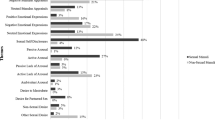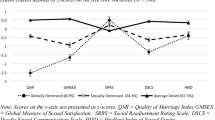Abstract
The goal of this study was to improve our understanding of men’s sexual response and its components as well as the factors or types of situations that men describe as facilitating or interfering with sexual arousal. Six focus groups, involving 50 mostly white, heterosexual men (M age = 35.2 years; range, 18–70), were conducted. As it was previously found in women (Graham, Sanders, Milhausen, & McBride, Archives of Sexual Behavior, 33, 527–538, 2004), men described a wide range of physical (genital as well as nongenital) and cognitive/affective cues for sexual arousal. Also, men described the relationship between sexual desire and arousal as being variable and complex, presented a wide range of factors that increased or decreased sexual arousal, and showed substantial variability in both the importance and direction of their effects. The findings may help further development of models of sexual response and inform discussions about gender differences in sexual desire and arousal.
Similar content being viewed by others
Notes
While this implies a role for social and cultural factors (e.g., socialization), these findings can also be considered consistent with parental investment and evolutionary theory (e.g., Buss, 1994).
References
Anderson, P., & Sorenson, W. (1996). Male and female differences in reports of women’s heterosexual initiation and aggression. Archives of Sexual Behavior, 28, 243–253.
Bancroft, J. (1990). Man and his penis—a relationship under threat? Journal of Psychology and Human Sexuality, 2, 7–32.
Bancroft, J. (1999). Central inhibition of sexual response in the male: A theoretical perspective. Neuroscience and Biobehavioral Reviews, 23, 763–784.
Bancroft, J., & Janssen, E. (2000). The dual control model of male sexual response: A theoretical approach to centrally mediated erectile dysfunction. Neuroscience and Biobehavioral Review, 24, 571–579.
Bancroft, J., Janssen, E., Strong, D., Carnes, L., Vukadinovic, Z., & Long, J. S. (2003). The relation between mood and sexuality in heterosexual men. Archives of Sexual Behavior, 32, 217–230.
Bancroft, J., Janssen, E., Strong, D., & Vukadinovic, Z. (2003). The relation between mood and sexuality in gay men. Archives of Sexual Behavior, 32, 231–242.
Barlow, D. H. (1986). Causes of sexual dysfunction: The role of anxiety and cognitive interference. Journal of Consulting and Clinical Psychology, 54, 140–157.
Barlow, D. H., Becker, R., Leitenberg, H., & Agras W. (1970). A mechanical strain gauge for recording penile circumference change. Journal of Applied Behavior Analysis, 6, 355–367.
Basson, R. (2002a). Are our definitions of women’s desire, arousal and sexual pain disorder too broad and our definition of orgasmic disorder too narrow? Journal of Sex and Marital Therapy, 28, 289–300.
Basson, R. (2002b). A model of women’s sexual arousal. Journal of Sex and Marital Therapy, 28, 1–10.
Brod, H. (1988). Pornography and the alienation of male sexuality. Social Theory and Practice, 14, 265–284.
Buss, D. (1994). The evolution of desire. New York: St. Martin’s Press.
Carpenter, D., Janssen, E., Graham, C., Vorst, H., & Wicherts, J. (2007). Women’s scores on the Sexual Excitation/Sexual Inhibition Scales (SIS/SES): Gender similarities and differences. Journal of Sex Research, in press.
Connell, R. W. (1995). Masculinities. Berkeley, CA: University of California Press.
Dworkin, S. L., & O’Sullivan, L. (2005). Actual versus desired initiation patterns among a sample of college men: Tapping disjunctures within traditional male sexual scripts. Journal of Sex Research, 42, 150–158.
Freund, K. (1963). A laboratory method for diagnosing predominance of homo- or hetero-erotic interest in the male. Behaviour Research and Therapy, 1, 85–93.
Graham, C., Sanders, S., & Milhausen, R. (2006). The sexual excitation/sexual inhibition inventory for women: Psychometric properties. Archives of Sexual Behavior, 35, 397–409.
Graham, C., Sanders, S., Milhausen, R., & McBride, K. (2004). Turning on and turning off: A focus group study of the factors that affect women’s sexual arousal. Archives of Sexual Behavior, 33, 527–538.
Jack, A. I., & Roepstorff, A. (2002). Introspection and cognitive brain mapping: From stimulus-response to script-report. Trends in Cognitive Sciences, 6, 333–339.
Janssen, E., & Bancroft, J. (2007). The dual-control model: The role of sexual inhibition and excitation in sexual arousal and behavior. In E. Janssen (Ed.), The psychophysiology of sex (pp. 197–222). Bloomington, IN: Indiana University Press.
Janssen, E., Carpenter, D., & Graham, C. (2003). Selecting films for sex research: Gender differences in erotic film preference. Archives of Sexual Behavior, 32, 243–251.
Janssen, E., & Everaerd, W. (1993). Determinants of male sexual arousal. Annual Review of Sex Research, 4, 211–245.
Janssen, E., Everaerd, W., Spiering, M., & Janssen, J. (2000). Automatic processes and the appraisal of sexual stimuli: Toward an information processing model of sexual arousal. Journal of Sex Research, 37, 8–23.
Janssen, E., Vorst, H., Finn, P., & Bancroft, J. (2002a). The sexual inhibition (sis) and sexual excitation (SES) scales: I. Measuring sexual inhibition and excitation proneness in men. Journal of Sex Research, 39, 114–126.
Janssen, E., Vorst, H., Finn, P., & Bancroft, J. (2002b). The sexual inhibition (SIS) and sexual excitation (SES) scales: II. Predicting psychophysiological response patterns. Journal of Sex Research, 39, 127–132.
Kaplan, H. S. (1977). Hypoactive sexual desire. Journal of Sex and Marital Therapy, 3, 3–9.
Kaplan, H. S. (1979). Disorders of sexual desire. New York: Brunner/Mazel.
Lief, H. I. (1977). What’s new in sex research? Inhibited sexual desire. Medical Aspects of Human Sexuality, 11(7), 94–95.
Lykins, A., Janssen, E., & Graham, C. A. (2006). The relationship between negative mood and sexuality in heterosexual college women and men. Journal of Sex Research, 43, 136–143.
Masters, W. H., & Johnson, V. E. (1966). Human sexual response. New York: Little, Brown and Company.
Morgan, D. L. (1997). Focus groups as qualitative research (2nd ed.). Thousand Oaks, CA: Sage.
Nicolson, P., & Burr, J. (2003). What is ‘normal’ about women’s (hetero)sexual desire and orgasm?: A report of an in-depth interview study. Social Science and Medicine, 57, 1735–1745.
Nisbett, R. E., & Wilson, T. D. (1977). Telling more than we can know: Verbal reports on mental processes. Psychological Review, 84, 231–259.
Palace, E. M. (1995). A cognitive-physiological process model of sexual arousal and response. Clinical Psychology: Science and Practice, 2, 370–384.
Robinson, M. D., Johnson, J. T., & Shields, S. A. (1998). The gender heuristic and the database: Factors affecting the perception of gender-related differences in the experience and display of emotions. Basic and Applied Social Psychology, 20, 206–219.
Seal, D. W., Bogart, L. M., & Ehrhardt, A. A. (1998). Small group dynamics: The utility of focus group discussions as a research method. Group Dynamics: Theory, Research, and Practice, 2, 253–266.
Seal, D. W., & Ehrhardt, A. A. (2003). Masculinity and urban men: Perceived scripts for courtship, romantic, and sexual interactions with women. Culture, Health & Sexuality, 5, 295–319.
Sintchak, G., & Geer, J. H. (1975). A vaginal plethysmograph system. Psychophysiology, 12, 113–115.
The Working Group for a New View of Women’s Sexual Problems. (2001). A new view of women’s sexual problems. In E. Kaschak & L. Tiefer (Eds.), A new view of women’s sexual problems (pp. 1–8). New York: The Haworth Press.
Tiefer, L. (1986). In pursuit of the perfect penis: The medicalization of male sexuality. American Behavioral Scientist, 29, 579–599.
Tiefer, L. (1991). Historical, scientific, clinical, and feminist criticisms of “The Human Sexual Response Cycle” model. Annual Review of Sex Research, 2, 1–23.
Tiefer, L. (2001). A new view of women’s sexual problems: Why new? Why now? Journal of Sex Research, 38, 89–96.
Tolman, D. L., Spencer, R., Harmon, T., Rosen-Reynose, M., & Striepe, M. (2004). Getting close, staying cool: Early adolescent boys’ experiences with romantic relationships. In N. Way & J. Y. Chu (Eds.), Adolescent boys: Exploring diverse cultures of boyhood (pp. 235–255). New York: New York University Press.
West, C., & Zimmerman, D. (1987). Doing gender. Gender and Society, 1, 125–151.
Wilkinson, S. (1999). Focus groups. A feminist method. Psychology of Women Quarterly, 23, 221–244.
Wilson, T. D., & Dunn, E. (2004). Self-knowledge: Its limits, value, and potential for improvement. Annual Review of Psychology, 55, 493–518.
Acknowledgments
This study was supported by the Office of the Associate Dean for Research of the School of Health, Physical Education and Recreation, Indiana University.
Author information
Authors and Affiliations
Corresponding author
Rights and permissions
About this article
Cite this article
Janssen, E., McBride, K.R., Yarber, W. et al. Factors that Influence Sexual Arousal in Men: A Focus Group Study. Arch Sex Behav 37, 252–265 (2008). https://doi.org/10.1007/s10508-007-9245-5
Received:
Revised:
Accepted:
Published:
Issue Date:
DOI: https://doi.org/10.1007/s10508-007-9245-5




